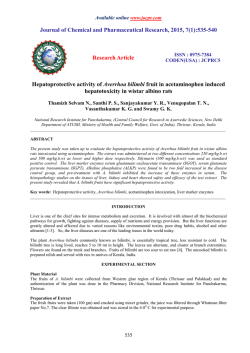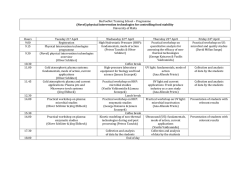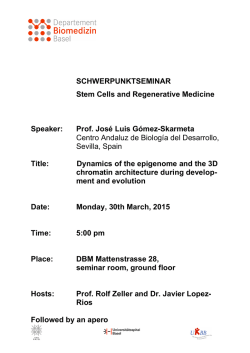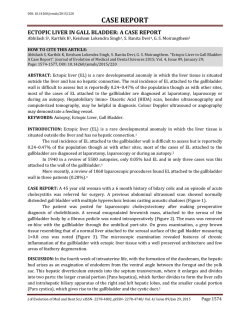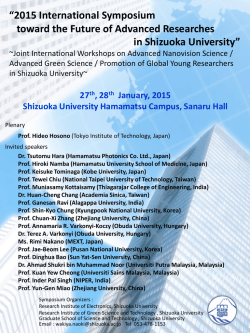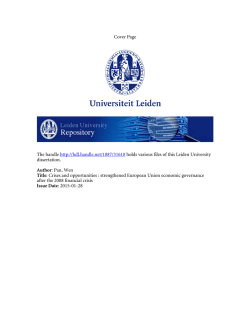
EASL Recognition Awardee 2013: Professor Jesus Prieto
Editorial EASL Recognition Awardee 2013 Professor Jesus Prieto Mario Strazzabosco⇑ Department of Surgery and Interdisciplinary Medicine, University of Milan-Bicocca, Milan, Italy; Section of Digestive Diseases, Yale University, New Haven, CT, USA During the 2013 International Liver Congress in Amsterdam, EASL recognized the career and achievements of Professor Jesus Prieto. Hepatologists from all over the world celebrated the liver scholar, scientist, mentor, academic leader, physician and, for many of us, the friend. We recognize somebody because they have given testimony: Prof. Jesus Prieto showed us how to enjoy the richness of academic life through the interaction with our students, colleagues and patients, and how enthusiasm and curiosity can bring us into a dimension beyond biology and mechanisms. Jesus Prieto is Professor of Medicine at the University of Navarra, and Consultant of Medicine at the University Clinic. He has held leadership roles in several national and international scientific societies and has received a number of international awards and honors. He has published hundreds of peer-reviewed highly quoted papers in the fields of immune-mediated liver disease, biliary diseases, and gene therapy of the liver. Prof. Prieto received his MD degree at the University of Valladolid (Spain), where he specialized in Internal Medicine and Gastroenterology. In 1972 Jesus, at that time an Assistant Professor, moved to London where he worked as a post-doctoral fellow with Professor Sheila Sherlock at the Royal Free Hospital. Working with Prof. Sherlock, he developed a method to measure serum ferritin and demonstrated its value in estimating liver iron stores and to guide venesection therapy in hemochromatosis. The resulting paper, published in 1975, became the first Gastroenterology paper of Jesus Prieto. Dr. Prieto moved back to Valladolid, in 1977, and he became Professor of Medicine at the University of Santiago de Compostela. Finally, in 1980, he walked the ‘‘Camino the Santiago’’ backward and reached his final destination, the University of Navarra in Pamplona, Spain. He quickly became one of the most influent members of the faculty and the School of Medicine and became Chairman of Medicine. Prof. Prieto is a visionary academic leader! He guided the Hepatology section of the University of Navarra towards international recognition and excellence and then envisioned a research ⇑ Address: Department of Surgery and Interdisciplinary Medicine, University of Milan-Bicocca, Via Cadore 48, 20900 Monza (MB), Italy. Tel.: +39 02 6448 8052; fax: +39 02 6448 8262. E-mail address: [email protected]. center where new knowledge in liver molecular biology could be translated into clinical applications and eventually developed into products through a joint venture between the University and some of the most important and innovative industries of the country. Soon enough, the Centre for Applied Medical Research (CIMA) was born. I am familiar with Prof. Prieto scientific accomplishments, having collaborated with him in several different occasions. Our collaboration began in 1993, when I was invited to spend three months in Pamplona, as a recipient of a BBV Chair. I have very fond memories of those times, and I distinctly remember Jesus going around the laboratories, approaching every single student, post doc and faculty, with a big smile. He would first of all ask them a few questions, beyond the work. One could immediately sense that, with each collaborator, there was a personal narrative that was updated each time. Only after Jesus would move on to the question that was lingering in his mind: ‘‘Any good result today?’’ When the answer was yes, he would first absorb the good news and then come back a few times during the day with questions and plans for further studies. Journal of Hepatology 2013 vol. 59 j 408–410 JOURNAL OF HEPATOLOGY Prof. Prieto possesses an extraordinary curiosity and ability to see connections among different areas and disciplines, and to think ‘‘out of the box’’. His scientific approach is consistently novel and he is never afraid of new challenges. Prof. Prieto’s scientific achievements are too many to mention. Suffice it to say that he has made seminal discoveries in the field of immunemediated liver diseases and cholangiopathies and that he has been a pioneer on probing the use of gene therapy in the treatment/prevention of liver disease. Characterized by a strong translational commitment, his research has developed in 3 main areas. Bile secretion and pathogenic mechanisms of PBC. Early in the ‘90s, he showed that AE2 gene expression was reduced in patients with PBC and introduced the concept that AE2 deficiency contributes to the pathogenesis of this condition [1]. In a longlasting collaboration with Dr. Medina, he identified AE2 as the molecule that mediates Cl/HCO3 exchange in the canalicular membrane of hepatocytes and to the lumenal membrane of cholangiocytes [2–5]. His team designed a PET-based methodology for non-invasive analysis of biliary bicarbonate secretion and was able to show that this process is compromised in PBC patients and that UDCA therapy can partially revert the bicarbonate secretory defect [6]. Together with Dr. Medina and Dr. OudeElferink, he generated an AE2 deficient mouse. This animal model was found to recapitulate most of the features of PBC, including anti-mitochondrial antibodies and immune dysregulation, thus supporting the view that AE2 deficiency may be a key factor in the pathogenesis of PBC [7]. These findings supported the novel concept that defective secretion of bicarbonate contributes to the pathogenesis of PBC by exposing the biliary epithelium to the toxic effect of bile salts, and by altering immune cell functions. The role of cytokines and growth factors in liver pathophysiology. In 1991, Prof. Prieto provided evidence of the role of TGFb in liver fibrogenesis and of the antifibrogenic effect of alpha-interferon in patients with chronic hepatitis C. This seminal paper was published in the New England Journal of Medicine in 1991, in collaboration with Dr. Castilla and Dr. Fausto [8]. In collaboration with Dr. Berasain and Dr. Avila, he unveiled a key role of amphiregulin, an EGF receptor ligand, in the process of liver regeneration [9], liver carcinogenesis [10,11], and the promotion of liver fibrosis [12]. The same team has recently identified fibroblast growth factor 15 as a novel mediator of liver regeneration and its application in the prevention of post-resection liver failure in mice [13]. In collaboration with Dr. Bustos, he clarified the role of cardiotrophin-1 (CT-1), a potent cytoprotective and anti-inflammatory molecule, constitutively expressed by parenchymal and non-parenchymal liver cells, that defends the liver against a variety of liver insults including ischemia/ reperfusion injury [14], Con-A-induced hepatitis [15], Fasinduced cell death [16], and acute liver failure [17]. More recently, he has shown that CT-1 displays important metabolic functions, including anti-lipogenic and insulin sensitizing activities [18]. The possible therapeutic value of CT-1 is currently being explored. Among other growth factors studied, Prof. Prieto addressed the role of IGF-I deficiency in the pathophysiology of liver cirrhosis, and showed that IGF-I replacement resulted in improvement of liver function and regression of liver fibrosis in animal models [19–22]. Liver gene therapy. With his team at CIMA, Prof. Prieto has been a pioneer in the field of liver gene therapy in Europe. He has designed original methodologies to treat liver and GI cancers in animal models, using novel vectors and transgenes [23,24]. In the early 2000s, he took the lead of cancer gene therapy, treating patients with primary and metastatic liver cancer by injecting the tumor with first generation adenovirus encoding IL-12 [25] or by injecting dendritic cells engineered to express IL-12 [26]. He also made seminal contributions by providing experimental proof of concepts of the use of gene therapy to modulate cytokine production and treat chronic liver disease, as well as viral hepatitis. HCV hepatitis has been an interest of Prof. Prieto: together with Dr. Civeira, he contributed to introduce the concept that rapid virologic response was predictive of treatment outcome in patients with chronic hepatitis C [27]. This is just a small summary of Prof. Prieto’s vast scientific interests. The inventor of 15 patents, Jesus Prieto has published more than 300 papers in peer-reviewed international journals. Part of his work was published in high-rank general journals such as the New England Journal of Medicine, Journal of Experimental Medicine, Journal of Clinical Investigation, Cell Metabolism and PNAS, in addition to Gastroenterology, Hepatology, Journal of Hepatology and Gut. Jesus Prieto is a former member of the EASL Scientific Committee, former President of the Spanish Association for the Study of the Liver, and former Chair of the International Committee of the American Society of Cell and Gene Therapy. He has received Honoris Causa Doctorates from the University of Porto (Portugal) and from the University Austral (Buenos Aires, Argentina). The impressive impact of Prof. Prieto in the field of Medicine is also demonstrated by the number of fellows and students that he has trained. Many of them now hold faculty positions in academic institutions in Spain and abroad. This brief account of Prof. Prieto’s accomplishments would be incomplete without mentioning his professional qualities as an academic physician. He is a consummate teacher, an astute physician, and a compassionate and humane doctor, who is beloved by his patients. In summary, Prof. Prieto embodies the very model of the Physician-Scientist, who successfully performs as a scientist, teacher, and physician. European Hepatology is fortunate to have him among its leaders and the Governing Board of EASL wishes him further personal and scientific success in the years to come. References [1] Prieto J, Qian C, García N, Díez J, Medina JF. Abnormal expression of anion exchanger genes in primary biliary cirrhosis. Gastroenterology 1993;105:572–578. [2] Martínez-Ansó E, Castillo JE, Díez J, Medina JF, Prieto J. Immunohistochemical detection of chloride/bicarbonate anion exchangers in human liver. Hepatology 1994;19:1400–1406. [3] Medina JF, Martínez-Ansó, Vazquez JJ, Prieto J. Decreased anion exchanger 2 immunoreactivity in the liver of patients with primary biliary cirrhosis. Hepatology 1997;25:12–17. [4] Banales JM, Arenas F, Rodríguez-Ortigosa CM, Sáez E, Uriarte I, Doctor RB, et al. Bicarbonate-rich choleresis induced by secretin in normal rat is taurocholate-dependent and involves AE2 anion exchanger. Hepatology 2006;43:266–275. [5] Arenas F, Hervias I, Uriz M, Joplin R, Prieto J, Medina JF. Combination of ursodeoxycholic acid and glucocorticoids upregulates the AE2 alternate promoter in human liver cells. J Clin Invest 2008;118:695–709. [6] Peñuelas I, Mazzolini G, Boán JF, Sangro B, Martí-Climent J, Ruiz M, et al. Positron emission tomography imaging of adenoviral-mediated transgene expression in liver cancer patients. Gastroenterology 2005;128:1787–1795. [7] Salas JT, Banales JM, Sarvide S, Recalde S, Ferrer A, Uriarte I, et al. Ae2a, bdeficient mice develop antimitochondrial antibodies and other features resembling primary biliary cirrhosis. Gastroenterology 2008;134:1482–1493. Journal of Hepatology 2013 vol. 59 j 408–410 409 Editorial [8] Castilla A, Prieto J, Fausto N. Transforming growth factors beta 1 and alpha in chronic liver disease. Effects of interferon alfa therapy. N Engl J Med 1991;324:933–940. [9] Berasain C, García-Trevijano ER, Castillo J, Erroba E, Lee DC, Prieto J, et al. Amphiregulin: an early trigger of liver regeneration in mice. Gastroenterology 2005;128:424–432. [10] Castillo J, Erroba E, Perugorría MJ, Santamaría M, Lee DC, Prieto J, et al. Amphiregulin contributes to the transformed phenotype of human hepatocellular carcinoma cells. Cancer Res 2006;66:6129–6138. [11] Castillo J, Goñi S, Latasa MU, Perugorría MJ, Calvo A, Muntané J, et al. Amphiregulin induces the alternative splicing of p73 into its oncogenic isoform DeltaEx2p73 in human hepatocellular tumors. Gastroenterology 2009;137:1805–1815. [12] Perugorria MJ, Latasa MU, Nicou A, Cartagena-Lirola H, Castillo J, Goñi S, et al. The epidermal growth factor receptor ligand amphiregulin participates in the development of mouse liver fibrosis. Hepatology 2008;48:1251–1261. [13] Uriarte I, Fernandez-Barrena MG, Monte MJ, Latasa MU, Chang HC, Carotti S, et al. Identification of fibroblast growth factor 15 as a novel mediator of liver regeneration and its application in the prevention of post-resection liver failure in mice. Gut 2013;62:899–910. [14] Iñiguez M, Berasain C, Martinez-Ansó E, Bustos M, Fortes P, Pennica D, et al. Cardiotrophin-1 defends the liver against ischemia-reperfusion injury and mediates the protective effect of ischemic preconditioning. J Exp Med 2006;203:2809–2815. [15] Bustos M, Beraza N, Lasarte JJ, Baixeras E, Alzuguren P, Bordet T, et al. Protection against liver damage by cardiotrophin-1: a hepatocyte survival factor up-regulated in the regenerating liver in rats. Gastroenterology 2003;125:192–201. [16] Marquès JM, Belza I, Holtmann B, Pennica D, Prieto J, Bustos M. Cardiotrophin-1 is an essential factor in the natural defense of the liver against apoptosis. Hepatology 2007;45:639–648. [17] Tuñon MJ, San Miguel B, Crespo I, Riezu-Boj JI, Larrea E, Alvarez M, et al. Cardiotrophin-1 promotes a high survival rate in rabbits with lethal fulminant hepatitis of viral origin. J Virol 2011;85:13124–13132. 410 [18] Moreno-Aliaga MJ, Pérez-Echarri N, Marcos-Gómez B, Larequi E, Gil-Bea FJ, Viollet B, et al. Cardiotrophin-1 is a key regulator of glucose and lipid metabolism. Cell Metab 2011;14:242–253. [19] Picardi A, de Oliveira AC, Muguerza B, Tosar A, Quiroga J, Castilla-Cortázar I, et al. Low doses of insulin-like growth factor-I improve nitrogen retention and food efficiency in rats with early cirrhosis. J Hepatol 1997;26:191–202. [20] Castilla-Cortazar I, Garcia M, Muguerza B, Quiroga J, Perez R, Santidrian S, et al. Hepatoprotective effects of insulin-like growth factor I in rats with carbon tetrachloride-induced cirrhosis. Gastroenterology 1997;113:1682–1691. [21] Cemborain A, Castilla-Cortázar I, García M, Quiroga J, Muguerza B, Picardi A, et al. Osteopenia in rats with liver cirrhosis: beneficial effects of IGF-I treatment. J Hepatol 1998;28:122–131. [22] Sanz S, Pucilowska JB, Liu S, Rodríguez-Ortigosa CM, Lund PK, Brenner DA, et al. Expression of insulin-like growth factor I by activated hepatic stellate cells reduces fibrogenesis and enhances regeneration after liver injury. Gut 2005;54:134–141. [23] Hu J, Dong A, Fernandez-Ruiz V, Shan J, Kawa M, Martínez-Ansó E, et al. Blockade of Wnt signaling inhibits angiogenesis and tumor growth in hepatocellular carcinoma. Cancer Res 2009;69:6951–6959. [24] Gonzalez-Aparicio M, Alzuguren P, Mauleon I, Medina-Echeverz J, HervasStubbs S, Mancheno U, et al. Oxaliplatin in combination with liver-specific expression of interleukin 12 reduces the immunosuppressive microenvironment of tumours and eradicates metastatic colorectal cancer in mice. Gut 2011;60:341–349. [25] Sangro B, Mazzolini G, Ruiz J, Herraiz M, Quiroga J, Herrero I, et al. Phase I trial of intratumoral injection of an adenovirus encoding interleukin-12 for advanced digestive tumors. J Clin Oncol 2004;22:1389–1397. [26] Mazzolini G, Alfaro C, Sangro B, Feijoó E, Ruiz J, Benito A, et al. Intratumoral injection of dendritic cells engineered to secrete interleukin-12 by recombinant adenovirus in patients with metastatic gastrointestinal carcinomas. J Clin Oncol 2005;23:999–1010. [27] Gavier B, Martínez-González MA, Riezu-Boj JI, Lasarte JJ, Garcia N, Civeira MP, et al. Viremia after one month of interferon therapy predicts treatment outcome in patients with chronic hepatitis C. Gastroenterology 1997;113:1647–1653. Journal of Hepatology 2013 vol. 59 j 408–410
© Copyright 2025
